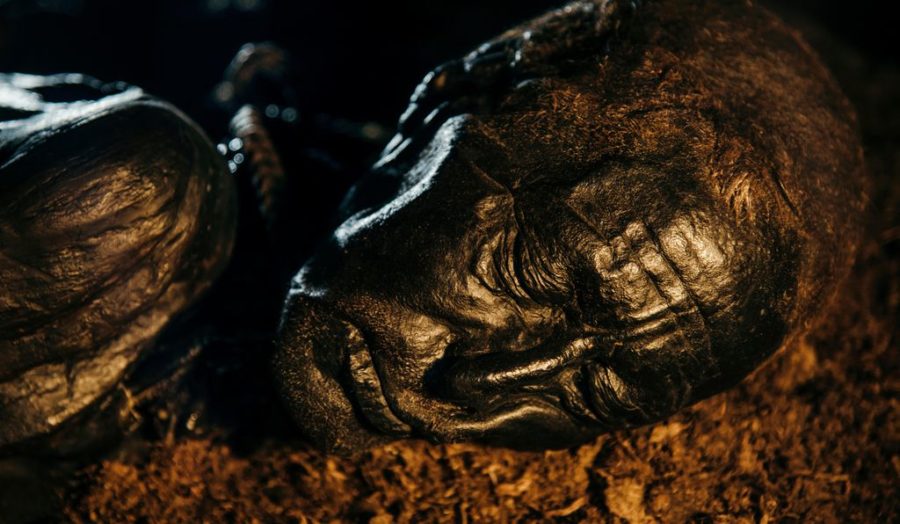Above: Tollund Man, discovered in a bog in 1950 near Silkeborg, Denmark, initially was thought to be the victim of a recent murder.

Written content from James Felton
In 1959, portrait artist and travel enthusiast Malika de Fernandez met the man who would become her murderer.
Within two hours, Peter Reyn-Bardt, an airline employee, asked her to marry him – and she said yes. Within four days, they were married.
A few months later, the marriage broke down, and Fernandez began to travel the world again, now using her new husband’s airline travel discount. Reyn-Bardt remained at his cottage in Cheshire, England.
Two years later, Fernandez disappeared completely, and Reyn-Bardt became suspect number one. Despite thorough searches of his property – including digging up his garden in search of her remains – the police weren’t able to find any evidence of Malika or any wrongdoing. The case remained unsolved for two decades when events took an odd twist: part of a body was discovered within a peat bog near the home of Reyn-Bardt’s cottage.
At this point, Reyn-Bardt’s embarrassing lack of knowledge of peat bogs came back to bite him, and ended with his conviction for her murder.
Peat is created through the decomposition of organic matter, largely from plant materials such as moss. When sphagnum moss, in particular, accumulates in wetlands enough to form a bog, the layers of peat form acids that are incredibly good at preserving bodies. Fall into one of these – or get murdered or sacrificed and thrown into one of these – and when you get discovered centuries later, you very well could look like somebody who fell in yesterday while playing dress up as a murdered 400 BCE peasant.
If Reyn-Bardt had known this, he might not have been so quick to confess to killing his wife.
After the head of an unknown woman was found in the Lindow Moss peat bog, forensics initially believed it to be 30-50 years old, and confronted Reyn-Bardt with the evidence, believing it to be related to the disappearance of Fernandez a few decades prior.
“It has been so long, I thought I would never be found out,” Reyn-Bardt told the police during questioning. He claimed that Fernandez had returned to his cottage sometime in the early 60s and threatened to reveal that he was gay – which was still criminalized in England at the time – if he didn’t give her money. Without any money, he said, they fought.
“Something just boiled over inside me,” he added, later telling the court that he had grabbed her and began shaking her, and didn’t realize he had killed her until he stopped.
“I was terrified and could not think clearly. The only thing that came to mind was to hide her.”
Reyn-Bardt said that he dismembered her body with an ax, before attempting to burn her. When this didn’t work, he took her to the nearby bog and threw her in.
The case, unsolved for 20 years, now seemed open and shut. But the lead investigator, Detective Inspector George Abbott, was bothered by something: if this was indeed Fernandez’s head, where was the rest of her? He sent off the skull for further analysis at Oxford University, at which point they discovered through carbon dating that the skull dated back to Roman times.
“The skull had been preserved in the peat bog for over 16 centuries and obviously has nothing to do with Malika Reyn-Bardt,” prosecutor Martin Thomas told the court. “But the supreme irony is this: its discovery led directly to the arrest of the defendant and to his detailed confession.”
When Reyn-Bardt learned of this, he attempted to withdraw his confession, but it was what’s known in the legal profession as “a bit late for takesies backsies”. It took the jury 3 hours to find him guilty of murder. Read more from IFLS
Man finds 2,000 year old body that didn’t decompose
A man stumbled across a decapitated head and a body that were extremely well-preserved, despite being around 2,000 years old.
Written content from Jak Connor
In the 1980’s a man stumbled across what he believed to be a leather football while he was working an operation to collect peat, or soil.
Andy Moul was working his operation in Wilmslow in Cheshire England when he came across a decapitated head of what was later believed to be a woman that was murdered in the area 20 years prior. However, carbon dating of the head found that it was over 1,600 years old. In the same location Mould later found toe tails that eventuated into the discovery of a leg that was later carbon dated to around 2,000 years old.
What was strange about the head and body part was how well preserved they were, as the head still had skin, hair and an eyeball still intact. How were these bodies parts so well-preserved? It has to do with the soils contents, as the bog where they were found contains acids that are extremely good at preserving bodies. An example of this is the famous Lindow man that was discovered in the peat bog near Manchester, England, who was found still wearing a hat on his chin, and had whiskers on his chin.
Carolyn Marshall in a Ted Talk said, “These plants acidify the soil while also releasing a compound that binds to nitrogen, depriving the area of nutrients. Alongside cold northern European temperatures, these conditions make it impossible for most microbes to function. With nothing to break them down, the dead mosses pile up, preventing oxygen from entering the bog.
The result is a naturally sealed system. Whatever organic matter enters a peat bog just sits there – like the Lindow Man.” Read more from TT





